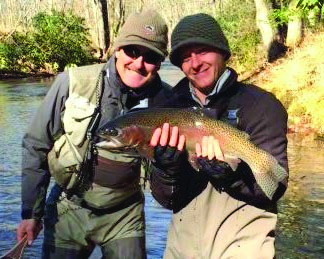by David Hulsey
The winter season is one of the most beautiful and serene times to be on the water. Long gone are the crowds of fall leaf lookers and throngs of fisher folk hanging out in every hole and run on your favorite trout stream. For sure, the thoughts of rising trout are still bubbling around in your head, but seldom do the icy waters of our highland streams squeeze out a bug while in winters frozen grip. The exceptionally weird warm sunny day in this season might show you a few Tiny Black Stones or Black Caddis or maybe a Black Midge or two. The likelihood of a trout having the will to break the surface after one of these little bugs is a long shot at best. Still though, I carry a small box of floating imitations just in case. If a trout pokes his nose through, I want to be there to greet him!
Normally, the slow moving, late morning arriving nymph fisher will be the lucky one with a bent rod at this time of year. The trout are usually glued to the bottom at first light and only an accurate presentation to the nose of the fish is about all that will trigger a reaction strike. When the sun gets above the horizon and bathes the river in golden light, the trout maybe will start to eat a little. One small degree of rise of water temperature is what you’re looking for. Spotting a single insect rising from the waters surface is a notable sign that the fishing is getting ready to get good.
Make it as easy as possible for the trout to eat your offering. If you can spot a fish, adjust the depth of your drift with weight, an indicator, or by mending until your fly is on the fish’s level. One sure way to tell if your flies are in their faces is to use a highly visible fly tied around a foot away from the nymph the fish should be eating. This way you can visibly see the flies approach the trout. If the fish “winks” at you, set the hook as he may have ate it! Or if the visible fly shifts position or stops drifting stick him! A good pair of polarized glasses are required to do this and are as valuable as your fly rod as far as I’m concerned.
Give us a call to set up your holiday season fly fishing trip. Noontootla Creek Farms fishes great in the winter, so check out our website at www.ncfga.com and get ready for some cold weather action!
Catching your first trout on the fly rod is usually an event that kind of sticks with you through the years afterward as a reminder of what it takes to get there. Granted, sometimes there are a few years that can pass between beginning to fly fish and the first trout landed. Some folks get one to the net on the first trip and others may take a few tries to put it all together. Fly fishing is a journey as all arts should be. In the “I want it now” generation we live in today, thank goodness a few things take a little learned skill and effort to obtain.
For me, I can still see that dark green back of that twelve-inch wild rainbow slip out from under that moss covered boulder on Bone Valley Creek in the Great Smoky Mountains National Park. Slowly and confidently he drifted out to suck in a big size 12 Fan Wing Royal Coachman dry fly. Some 40 years later I can still feel the tug and the bend in my old Shakespeare Wonder Rod! I knew at that moment my life had changed forever as a new fly fisher had been born on that warm spring day.
Now a lot of water has flowed beneath my wading boots since then, and I have seen thousands of beginners catch their first trout. The look on their face still makes me pull on my frosty wading boots on a winter morning in anticipation of hearing the laughter and seeing the amazement in the faces of a newly born fly angler. I know without a doubt this is what I want to do for the rest of my days here.
Over the years I’ve picked up on a few things that can make the journey a little easier for the beginner to land a trout or two.
Number one is to fish where the trout are. I see so many folks on sections of streams where there is no fish. Water temperature, stocking schedules and fishing pressure can wreak havoc on certain streams, and it will pay you to learn about all three.
Number two is where the fish position themselves in the stream. Don’t stand in waist deep water and cast to ankle deep water. Fish where you can’t see the bottom clearly. Trout use this for cover.
Number three is make your drifting fly act as naturally as possible. A fly dragging through the water is pretty much fish repellant at times. Learn to mend your fly line to take advantage of a good drift. The fish will reward you.
Number four is fish with a fly that the trout might actually associate with food. Learn these fly patterns and keep them in your fly box. A Pheasant Tail Nymph, an Elk Hair Caddis and an Olive Wooly Bugger will catch fish anywhere.
Number five is fish with confidence. Expect a trout to eat your fly on every good drift. That way you will be ready when he does.
Give us a call if you would like to give fly fishing a try for the first time. We make learning to fly fish easy and fun. Hey, we even provide all the gear! Call 770-639-4001 to book your fly fishing journey beginning today.
http://www.hulseyflyfishing.com/
